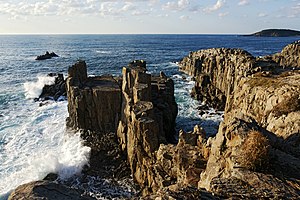Tōjinbō

Tōjinbō (東尋坊) is a series of basaltic cliffs on the Sea of Japan in Japan. It is located in the Antō part of Mikuni-chō in Sakai, Fukui Prefecture. The cliffs stretch for 1 km (3,281 ft).[1]
Formation
The cliffs' rocks were originally formed 12- to 13-million years ago during the Miocene Epoch due to various volcanic activities. Their shape has been formed through the years by erosion from sea waves.[1]
Legends
One legend has it that a corrupt Buddhist priest from Heisen-ji (平泉寺), a local temple, so enraged the populace that they dragged him from the temple to the sea and, at Tōjinbō, threw the priest into the sea. His ghost is still said to haunt the area.
An alternate legend says that the name Tōjinbō comes from a dissolute Buddhist monk. According to the legend, a Buddhist monk named Tōjinbō, who was disliked by everyone, fell in love with a beautiful princess named Aya. Tōjinbō was tricked by another admirer of Princess Aya and was pushed off these cliffs. The legend says that ever after that time Tōjinbō's vengeful ghost would go on a rampage around the same time every year at this place, causing strong winds and rain. Some decades later, an itinerant priest took pity on Tōjinbō and held a memorial service for him. After that, the storms ceased.
-
Sandan Rocks
-
Rosoku Rocks
-
Byobu Rocks
-
25 m (82 ft) high Oike
Suicide

Tōjinbō is also a well-known place in Japan to commit suicide. According to statistics, as many as 25 people[citation needed] commit suicide by jumping off the 70-foot-high cliffs annually, a number which has risen and fallen with Japan's national economic hardships and unemployment rates. Recently, a retired police officer, Yukio Shige, frustrated at having fished so many bodies out of the sea, began patrolling the cliffs for potential jumpers. He claims so far (December 2009) to have convinced more than two hundred people to not jump; he keeps in touch with every one of them to this day.[2]
References
- ^ a b Fukui | Tojinbo. Japan National Tourist Organization. Accessed April 30, 2008.
- ^ Fackler, Martin (Dec 18, 2009), "At Japanese Cliffs, a Campaign to Combat Suicide", New York Times, pp. A6




